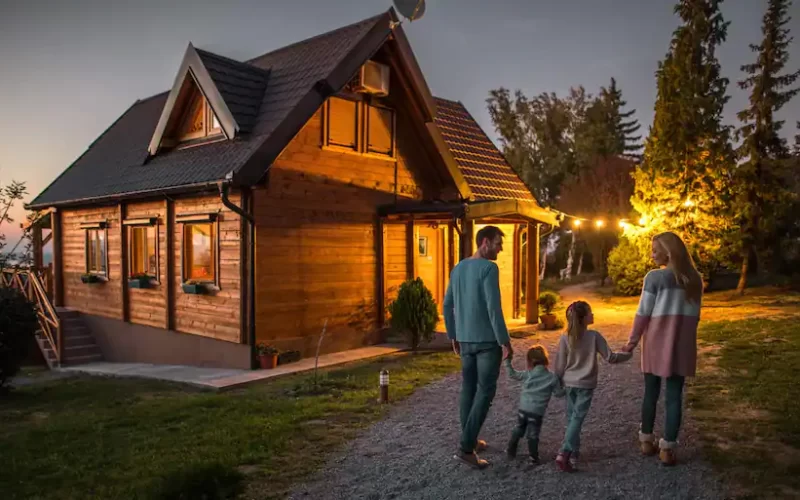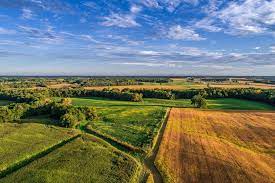You’ve made the decision to visit the Great Smoky Mountains. Naturally, you’ll want a fantastic spot to stay while you’re here. From condominiums to cabins to chalets, the region has a wide range of vacation hideaways with every type of amenity. Many visitors want to get away from the “big city” atmosphere of their homes and instead stay in a more “traditional” mountain cabin. Visitors are frequently perplexed by the options presented. One of the questions asked is, ‘what is the difference between a cabin house and a chalet-style home?’. Well, this and more questions will be answered in this guide.
Even if you’re not an armchair architect, you’ll be able to recognize a chalet-style house relatively immediately. These wood-framed houses, also known as Alpine or Swiss Chalets, were constructed for rural areas with uneven terrain. Thus, they make perfect holiday homes or primary residences for individuals seeking a pleasant, spacious living space in a rural setting.
What Is a Chalet Style Home?
A chalet-style home is a European-inspired home with sloping roofs, simple construction, and uncomplicated design that is common in alpine ski resorts, wooded lakeside towns, and vacation destinations where the main draw is the wonder of the great outdoors.
What Is The Purpose Of A Chalet?
Chalets were initially used to accommodate dairy cattle herders. During the summer, they were used to keep milk and butter in Switzerland and French Savoy. In fact, the word “chalet” means “shelter” or “herder’s hut” in Latin.
What Characterizes a Chalet Style Home?
Chalet-style homes are characterized by their dramatic, triangular design, steeply pitched roofs, and overhanging eaves, and are typically coated with wooden shingles. These roofs are great for cold climates. This is because they slope away from the house, preventing significant amounts of snow from gathering on top.
Traditional chalets have a small, compact footprint since they were originally designed to be erected on steep, uneven terrains. Thus, reducing the amount of excavation required for construction. Today’s chalets, however, are available in a variety of sizes and can be created to accommodate large families thanks to current building techniques and materials.
Chalet-style homes are created from natural materials that are left exposed and unadulterated to blend in with their pastoral settings, reflecting their Alpine background. The foundation is usually composed of stone or cement, and if the chalet is built on sloping land, the foundation will be visible from the downhill side.
The chalet style home is mostly made of wood, which is left unfinished except for being treated to withstand the elements. The color of a chalet is determined by the type of wood used to construct it. Historically, chalets were constructed with wood that was native to the area, but thanks to advancements in transportation and the globalization of the construction industry, chalets can now be constructed with lumber imported from all over the world. Though some homeowners prefer to paint over exposed wood, the majority of chalets on the market follow traditional European architectural principles.
How Are Chalet Homes Designed?
Chalet-style homes are nearly always two stories tall, with lots of windows that bring in plenty of natural light. These windows are also intended to provide spectacular views of the chalet’s surroundings, bridging the gap between indoors and out.
A chalet-style house’s interior is open-concept, evoking the warm community ambiance of a ski resort. An inside fireplace is almost always present in the main room, which naturally heats the main living area and helps to offset any cold air that may enter through the chalet’s enormous picture windows.
Though chalets have a modest footprint, their high vaulted ceilings give the impression of a house and openness. Loft chambers tower above the great room in many chalets, and they can be turned into bedrooms, home offices, or a cozy semi-private spot for quiet enjoyment.
Exteriors:
- A gabled roof with a pitch
- eaves that hang over the edge of the roof.
- A base made of stone or concrete.
- Framing with wood
- Natural wood that has been exposed
Interiors:
- Living room with an open-concept
- Ceilings with vaults
- Fireplace
- Windows with large image frames
History of Chalet Style Homes
The word “chalet” was first used in history in 1328 to describe the modest, crude log cabins built by farmers in the Canton de Vaud in Switzerland. Throughout most of history, the name “chalet” applied to any modest mountain house.
The modern-day chalet design was developed in the middle of the nineteenth century by French and English tourists to Switzerland who were influenced by native architecture. These visitors went home with romanticized images of Swiss chalets and began building beautiful, if not historically accurate, replicas of the houses they had loved during their journeys.
As the chalet-style became more popular, various Swiss enterprises began publishing chalet blueprints in catalogs, allowing anyone all over the world to build their own Swiss chalet. The catalogs showed a range of basic designs that could be personalized with a variety of features and flourishes, resulting in the ornate gingerbread-style houses that we now associate with the chalet style.
Chalets first became popular in the United States in the late 1800s in New England, where they blended in wonderfully with the cold, snowy, and frequently severe weather. Chalets, like other New England-born home types (such as bungalows), began to sprout up all across the country, particularly in Colorado’s mountainous regions.
What Is the Difference Between a Chalet and a Cabin?
A chalet is almost the same thing as a cabin, but they’re both different. Let’s see the difference between a chalet and a cabin:
Cabin
In today’s Smoky Mountains, the term “cabin” refers to any mountain or vacation home. A cabin, however, is a tiny house made of logs.
Unlike a true house, a cabin is usually a simple building. A cabin’s architecture is less “finished” or sophisticated. The log cabin is a reminder of simpler times.
Cabins are commonly connected with frontier America’s rustic and rural settings. The log cabin is a Scandinavian and Eastern European design. European settlers took their log-building traditions to North America, where they built homes, barns, and other community structures.
When early settlers built their homes, they took into account a variety of factors. Size, the number of stories, roof type, door and window arrangement, and even the sort of labor available are all factors to consider. The most crucial decision was the cabin’s location. In order for the occupants of a frontier cabin to adequately cope with the trials of life on the frontier, it was required to offer ample sunshine and drainage.
A “log home,” or a classic-style house built from milled logs, is a modern-day log cabin. These logs are often visible on the outside of the house, as well as on the inside for rustic charm. The original style has been updated to provide modern facilities.
Chalet
A chalet, on the other hand, is a wooden structure with a sloping roof and eaves that extend far overhanging. The chalet is a design that originated in Switzerland and other Alpine countries. The name was originally used to designate a sheep or goat herder’s cottage. Many European chalets served as summer dairy farms.
Today, the term “chalet” refers to any typical Swiss-style home or lodge. A chalet is a structure with dining spaces, spas, and other tourist-oriented amenities in several holiday destinations. Some of them don’t even resemble typical Swiss architecture.
What Is a Bungalow Chalet?
Bungalows were small houses with thatched roofs in the past. A chalet bungalow is a bungalow with a little living house on the second level or in the loft. A bungalow is commonly defined as a one-story construction that is separate from other structures. The chalet bungalow, on the other hand, is still basically a bungalow because it meets the other characteristics that define a bungalow-style house. The chalet bungalow, like other forms of bungalow houses, has its origins in India, where the building was once a common working-class house. Bungalows are typically one-story homes with a front veranda, an open-air covered porch. They were traditionally thatched-roof dwellings that were simple and inexpensive to construct. Bungalows today are constructed with high-quality materials and follow the traditional design.
A second-story loft in a chalet home can be transformed into a residential space.
Is a Chalet Bungalow Same as a House?
The chalet bungalow has the same sloping roof and gables as the other homes. Bungalows can be designed to have the same amount of living space as other types of houses. However, their footprint is often greater than other types of houses. This also necessitates a larger yard for a cottage to be built on. Increased privacy is one of the benefits of a bungalow. This is so since properly placed trees and bushes can block views from the outside. They’re also handy because they have all of the living areas on one floor, which eliminates the need for stairs. During the summer, the veranda outside the house expands the usable living area.
The second-story loft of a chalet home, on the other hand, can be transformed into a living space. Because it is directly beneath the roof, the loft is often modest. And in most bungalows, such space is primarily utilized for storage. The chalet bungalow, unlike a regular bungalow, makes use of this area for a bedroom or other living space. Most people still consider it a bungalow because all of the primary living rooms are on the first floor, despite the fact that it officially does not fit the characteristics of a true bungalow.
A style like this is ideal for small households with young children. The upper living area can be used as a children’s bedroom, while the main living area and bedroom stay downstairs. Bungalows were once small dwellings for India’s poor and working-class, and current versions are often small as well. Families who require storage, guest space, or bedroom space will benefit greatly from the loft area.
Investing in a Chalet: Some Pointers
During the off-season, a chalet-style house can be a fantastic country house to enjoy while paying for much, if not all, of the associated expenses from high-dollar short-term rentals. The chalet’s distinctive ambiance and architectural qualities make it a desirable rental property with high rental rates.
During the high season, a chalet near Breckenridge, Colorado, can earn between $110 and $900 per night. Depending on amenities, size, location, and décor, this corresponds to $3,300 to $27,000 per month. To create consistent high-dollar bookings, it’s a good idea to choose a rural house near a desirable ski region.
Just keep in mind that short-term rentals come with a slew of extra fees. These include cleaning services and booking or management fees. And, if this is going to be an investment property or a second home, you’ll almost certainly need to put down a minimum of 20%.
As a general guideline, you’ll need a steady source of income, a higher-than-average credit score, and a low debt-to-income ratio to qualify for a loan. Because you’ll need liability insurance in addition to homeowners insurance, the cost of insurance is usually higher.
Can You Get A Mortgage On A Chalet?
No, you can’t normally get a mortgage on a chalet. This is primarily because mortgages are based on your title as a property owner in the HM Land Registry, but when you invest in a holiday chalet, you do not own the real land.
Is Holiday Chalet A Good Investment?
A vacation resort is a great investment. For starters, its virtual cost is significantly lower than that of traditional vacation homes. Modern lodges are energy-efficient, saving you money in the long term, and incorporate facilities such as on-site wi-fi.
In Conclusion,
Chalets have a lot of rental possibilities, but only if the location has enough demand. High-demand ski chalet areas generally have inflated real estate prices, making it impossible to purchase the property at a reasonable price to cover the additional costs of renting the unit.
So that the competition isn’t as severe, look near some of the smaller or more isolated but nonetheless desirable ski resorts. There are approximately 500 ski resorts in the United States, so there are lots of alternatives when it comes to buying a ski chalet near one. Depending on how much cash you have on hand, you could also look for a fixer-upper. This can often sell for less than market value even after renovations. Just remember to do your homework and run the figures. Also, think about the long-term implications of having a second home before signing on the dotted line.
What is A Chalet FAQs
What is the difference between a chalet and a cabin?
Cabin has traditionally been linked with a low, modest-sized, rough-hewn construction built from successive layers of lumber and having limited utilities, whereas a chalet is thought of as a magnificent, finely-constructed dwelling with all the comforts of home.
What makes a house a chalet?
Chalet-style homes are distinguished by their dramatic triangular appearance, steeply pitched roofs, and overhanging eaves, and are typically covered in wooden shingles. Since of their slope, these roofs are good for cold areas because they keep huge amounts of snow from collecting on top of the house.
How long does a chalet last?
Chalets can last for at least 80 years.
How many floors does a chalet have?
Modern-style chalets are often two-story homes with vast rooms and open floor plans.






